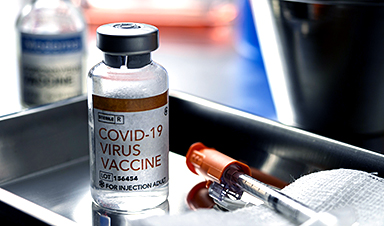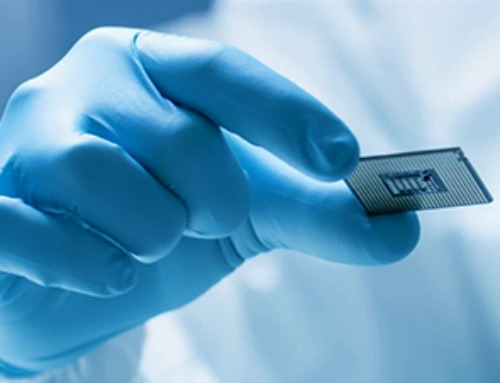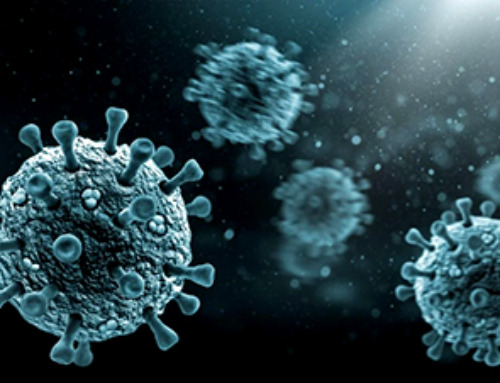University at Albany researchers at the RNA Institute have developed a new method to test COVID-19 vaccine integrity that could allow anyone with basic skills in vaccine handling to detect expired vaccines quickly and effectively, without specialized lab equipment.
By employing laser-derived signals to assess vaccine stability, the method can be performed on sealed vials with no disruption to the vaccine’s therapeutic effects. The system could be contained in a portable unit for easy transport and handling.
The research marks an important advancement in mRNA vaccine technology and was featured on the January 2024 cover of Analytical Chemistry.
“Current methods for testing the integrity of mRNA-based vaccines are destructive, time-consuming, costly and require highly skilled personnel,” said collaborator Lamyaa Almehmadi, who led this study as a Ph.D. student at UAlbany’s RNA Institute and is now working as a postdoc at MIT.
“There is an unmet need for a quick and easy method to test the stability of mRNA vaccines distributed to vaccine clinics, medical offices and pharmacies worldwide. To the best of my knowledge, our method is the first to enable an in-situ, non-destructive and reagent-free approach for mRNA stability analysis in mRNA-based vaccines.”
When the first mRNA vaccines for COVID-19 were being rolled out, concerns quickly emerged around vaccine transport and storage. This is because the vaccines rely on active mRNA molecules that can degrade with prolonged exposure to sunlight and/or temperatures outside the range of minus 80 to minus 20 degrees Celsius.
Although mRNA vaccines pose special logistical challenges, the global public health community has successfully implemented systems to maintain optimal conditions for vaccine stability. With these systems in place, this new method can provide an additional layer of assurance to guarantee vaccine stability and bolster confidence in their efficacy.
Using lasers to assess vaccine stability
The method employs a unique Raman spectroscopy instrument developed by UAlbany’s Igor Lednev, the Williams-Raycheff Endowed Professor in the Department of Chemistry. The technique involves pointing an ultraviolet (UV) laser into a liquid, which creates scattered light that can be detected and analyzed, revealing chemical signatures.
Since its invention about 20 years ago, Lednev’s lab has adapted the technology, combined with advanced machine learning, for various applications including forensic science and disease detection.
In this latest application, Lednev’s team developed a way to detect small changes in mRNA structure that indicate loss of therapeutic functionality.
“Our method works by shining a deep-UV laser through a vial of vaccine and collecting the resulting scattered light,” said Almehmadi.
“This scattered light is then detected by our instrument, and our software processes it to yield the RNA signature, known as the Raman spectrum. The mRNA Raman spectrum is then used for RNA degradation analysis. The test is rapid, typically taking just a few minutes to complete.”
Compact tech to improve accessibility
Unlike existing methods used to test vaccine stability which require specialized training and must be conducted in a lab, this method can be fully contained in a handheld instrument. It is also non-invasive, so could be used to test multiple vials of vaccine, which, if found to be stable, could then be administered.
“Individuals with basic training in handling vaccine vials and operating the instrument could utilize our method effectively in a variety of settings outside a lab,” said Almehmadi.
“Furthermore, with the assistance of advanced software, the process of data collection and results interpretation can be automated, making it accessible to a wider range of users.”
“The technology that we’ve developed in this study is universal in several important ways,” said Lednev.
“It allows for obtaining mRNA spectral characteristics in situ without disintegrating the vaccine capsule. It is also nondestructive; should the test result be positive, the vaccine could then be used for the treatment. For these reasons, our novel technology might find numerous applications for testing the stability of various mRNA vaccines, and mRNA therapeutics in general.”
Lednev notes that this work was a collaborative, interdisciplinary effort made possible with the expertise of Alexander Shekhtman and Sergei Reverdatto, both in UAlbany’s Department of Chemistry, who designed and prepared the model vaccines used in this study and conducted biochemical tests to evaluate vaccine stability.
More information: Lamyaa M. Almehmadi et al, In Situ Stability Test for mRNA Vaccines Based on Deep-UV Resonance Raman Spectroscopy, Analytical Chemistry (2023). DOI: 10.1021/acs.analchem.3c01761
Journal information: Analytical Chemistry
Provided by University at Albany
News
Global Nanomaterial Regulation: A Country-by-Country Comparison
Nanomaterials are materials with at least one dimension smaller than 100 nanometres (about 100,000 times thinner than a human hair). Because of their tiny size, they have unique properties that can be useful in [...]
Pandemic Potential: Scientists Discover 3 Hotspots of Deadly Emerging Disease in the US
Virginia Tech researchers discovered six new rodent carriers of hantavirus and identified U.S. hotspots, highlighting the virus’s adaptability and the impact of climate and ecology on its spread. Hantavirus recently drew public attention following reports [...]
Studies detail high rates of long COVID among healthcare, dental workers
Researchers have estimated approximately 8% of Americas have ever experienced long COVID, or lasting symptoms, following an acute COVID-19 infection. Now two recent international studies suggest that the percentage is much higher among healthcare workers [...]
Melting Arctic Ice May Unleash Ancient Deadly Diseases, Scientists Warn
Melting Arctic ice increases human and animal interactions, raising the risk of infectious disease spread. Researchers urge early intervention and surveillance. Climate change is opening new pathways for the spread of infectious diseases such [...]
Scientists May Have Found a Secret Weapon To Stop Pancreatic Cancer Before It Starts
Researchers at Cold Spring Harbor Laboratory have found that blocking the FGFR2 and EGFR genes can stop early-stage pancreatic cancer from progressing, offering a promising path toward prevention. Pancreatic cancer is expected to become [...]
Breakthrough Drug Restores Vision: Researchers Successfully Reverse Retinal Damage
Blocking the PROX1 protein allowed KAIST researchers to regenerate damaged retinas and restore vision in mice. Vision is one of the most important human senses, yet more than 300 million people around the world are at [...]
Differentiating cancerous and healthy cells through motion analysis
Researchers from Tokyo Metropolitan University have found that the motion of unlabeled cells can be used to tell whether they are cancerous or healthy. They observed malignant fibrosarcoma [...]
This Tiny Cellular Gate Could Be the Key to Curing Cancer – And Regrowing Hair
After more than five decades of mystery, scientists have finally unveiled the detailed structure and function of a long-theorized molecular machine in our mitochondria — the mitochondrial pyruvate carrier. This microscopic gatekeeper controls how [...]
Unlocking Vision’s Secrets: Researchers Reveal 3D Structure of Key Eye Protein
Researchers have uncovered the 3D structure of RBP3, a key protein in vision, revealing how it transports retinoids and fatty acids and how its dysfunction may lead to retinal diseases. Proteins play a critical [...]
5 Key Facts About Nanoplastics and How They Affect the Human Body
Nanoplastics are typically defined as plastic particles smaller than 1000 nanometers. These particles are increasingly being detected in human tissues: they can bypass biological barriers, accumulate in organs, and may influence health in ways [...]
Measles Is Back: Doctors Warn of Dangerous Surge Across the U.S.
Parents are encouraged to contact their pediatrician if their child has been exposed to measles or is showing symptoms. Pediatric infectious disease experts are emphasizing the critical importance of measles vaccination, as the highly [...]
AI at the Speed of Light: How Silicon Photonics Are Reinventing Hardware
A cutting-edge AI acceleration platform powered by light rather than electricity could revolutionize how AI is trained and deployed. Using photonic integrated circuits made from advanced III-V semiconductors, researchers have developed a system that vastly [...]
A Grain of Brain, 523 Million Synapses, Most Complicated Neuroscience Experiment Ever Attempted
A team of over 150 scientists has achieved what once seemed impossible: a complete wiring and activity map of a tiny section of a mammalian brain. This feat, part of the MICrONS Project, rivals [...]
The Secret “Radar” Bacteria Use To Outsmart Their Enemies
A chemical radar allows bacteria to sense and eliminate predators. Investigating how microorganisms communicate deepens our understanding of the complex ecological interactions that shape our environment is an area of key focus for the [...]
Psychologists explore ethical issues associated with human-AI relationships
It's becoming increasingly commonplace for people to develop intimate, long-term relationships with artificial intelligence (AI) technologies. At their extreme, people have "married" their AI companions in non-legally binding ceremonies, and at least two people [...]
When You Lose Weight, Where Does It Actually Go?
Most health professionals lack a clear understanding of how body fat is lost, often subscribing to misconceptions like fat converting to energy or muscle. The truth is, fat is actually broken down into carbon [...]





















